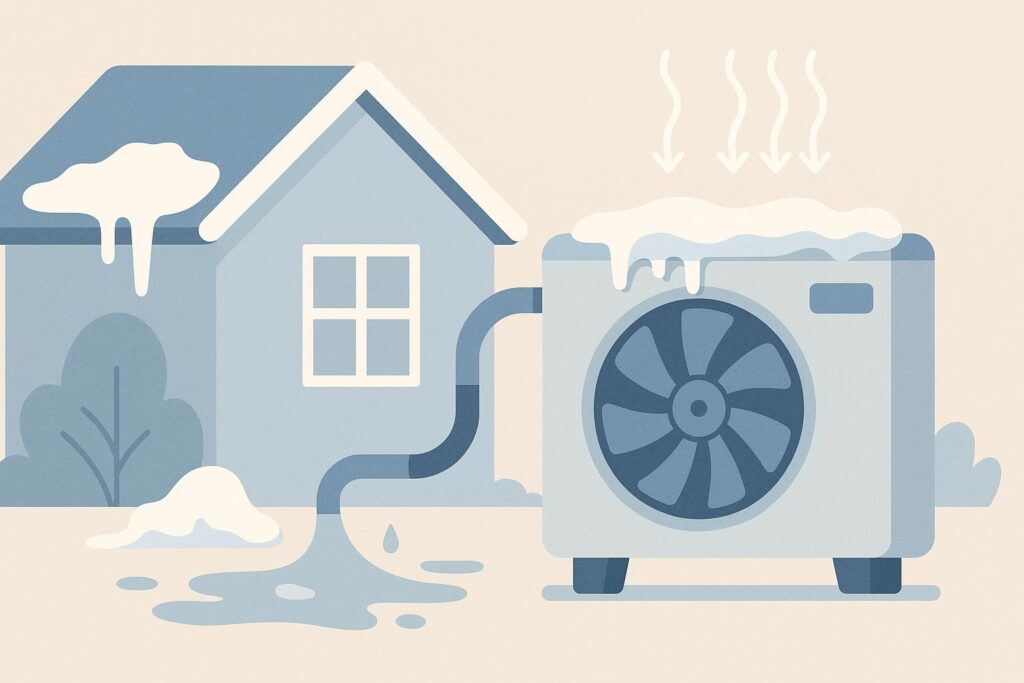If you’ve noticed your heat pump pausing or switching into a different mode on cold days, you’re probably witnessing a defrost cycle in action. As a team of expert heating engineers providing professional Heat Pump Repairs in Melksham, we’re often asked why defrost happens and how to tell what’s normal vs fault behaviour. Understanding this process helps homeowners prevent unnecessary worry and spot potential issues early. Our engineers also support nearby areas such as Trowbridge, Chippenham and Westbury, delivering reliable and efficient heat pump maintenance across Wiltshire.

What is a Heat Pump Defrost Cycle?
When outdoor temperatures drop below around 5°C, moisture in the air can freeze on the outdoor coil of your air source heat pump. This layer of frost insulates the coil and prevents it from absorbing heat efficiently. To remove that ice, the system automatically switches into a defrost cycle, reversing the refrigerant flow so the coil temporarily heats up, melting the frost before returning to normal operation.
A typical defrost cycle lasts between five and fifteen minutes depending on the outdoor temperature and humidity levels. Modern systems are designed to sense coil temperature and initiate defrost only when necessary, ensuring energy efficiency and consistent indoor comfort.
Why Defrost Happens
In winter, when humidity is high and temperatures hover around freezing, ice buildup becomes inevitable. The defrost cycle ensures your system continues running efficiently and avoids damage caused by ice restricting airflow or overworking the compressor. Without automatic defrosting, the unit would quickly lose performance and possibly freeze solid.
Most homeowners in the Melksham area notice defrost cycles happening more often after sleet or damp mornings. This is completely normal and doesn’t mean your heat pump has a problem. You might hear a soft whooshing noise when the cycle begins – this simply indicates the system has reversed operation to warm the outdoor coil.
What’s Normal vs Faulty Defrost Cycles
Understanding what’s normal vs fault gives you confidence during cold snaps. Here’s what to expect from a healthy system:
- Defrost occurs automatically on frosty or damp days.
- The fan on the outdoor unit stops temporarily while warm air melts the ice.
- Steam may rise from the unit briefly during the process.
- The system resumes heating once sensors confirm the coil is clear.
On the other hand, signs of a fault include:
- Frequent or prolonged defrost cycles (lasting over 20 minutes regularly).
- Constant icing on the outdoor coil that doesn’t clear properly.
- Low indoor heat output after defrost completes.
- Visible water pooling around the base for extended periods.
These symptoms might indicate sensor faults, low refrigerant charge, or restricted airflow around the unit. If you suspect a problem, it’s wise to arrange a service. You can learn more about fault finding in our guide on Common Heat Pump Problems.
Tips to Keep Your Heat Pump Defrosting Efficiently
To help your heat pump manage defrost cycles smoothly throughout winter, try the following expert tips:
- Keep the outdoor unit clear of snow, leaves or obstructions that could restrict air movement.
- Ensure condensate drains remain open so melted frost can drain away freely.
- Schedule routine servicing by a qualified engineer to check sensors and refrigerant charge.
- Consider a protective canopy to shield the unit from falling snow while maintaining airflow.
For advice on system selection and energy savings, read our post on Monobloc vs Split Heat Pump types and how the design affects defrost behaviour. If you’re concerned your home might need system upgrades, our guide Is Your Home Heat Pump Ready? explores essential preparations for optimal efficiency.
When to Call a Professional
If your system fails to heat properly after a defrost cycle or frequently freezes solid, don’t wait until severe weather worsens the problem. A skilled heating engineer can inspect sensors, the reversing valve, or refrigerant pressures to pinpoint the cause. At AN Heating, our qualified technicians operate across Wiltshire from Warminster to Bath, ensuring rapid, reliable repairs that keep homes comfortable all year round.
Conclusion
Understanding the heat pump defrost cycle is essential for every homeowner. It’s a vital, automatic feature that maintains system efficiency by preventing ice buildup and protecting your equipment from winter wear. However, if you notice erratic cycles or reduced heating performance, it’s best to get professional help.
For prompt, expert Heat Pump Repairs in Melksham and friendly advice, contact our team today. We’ll inspect your system, identify any issues, and ensure it’s working safely and efficiently throughout the colder months.
